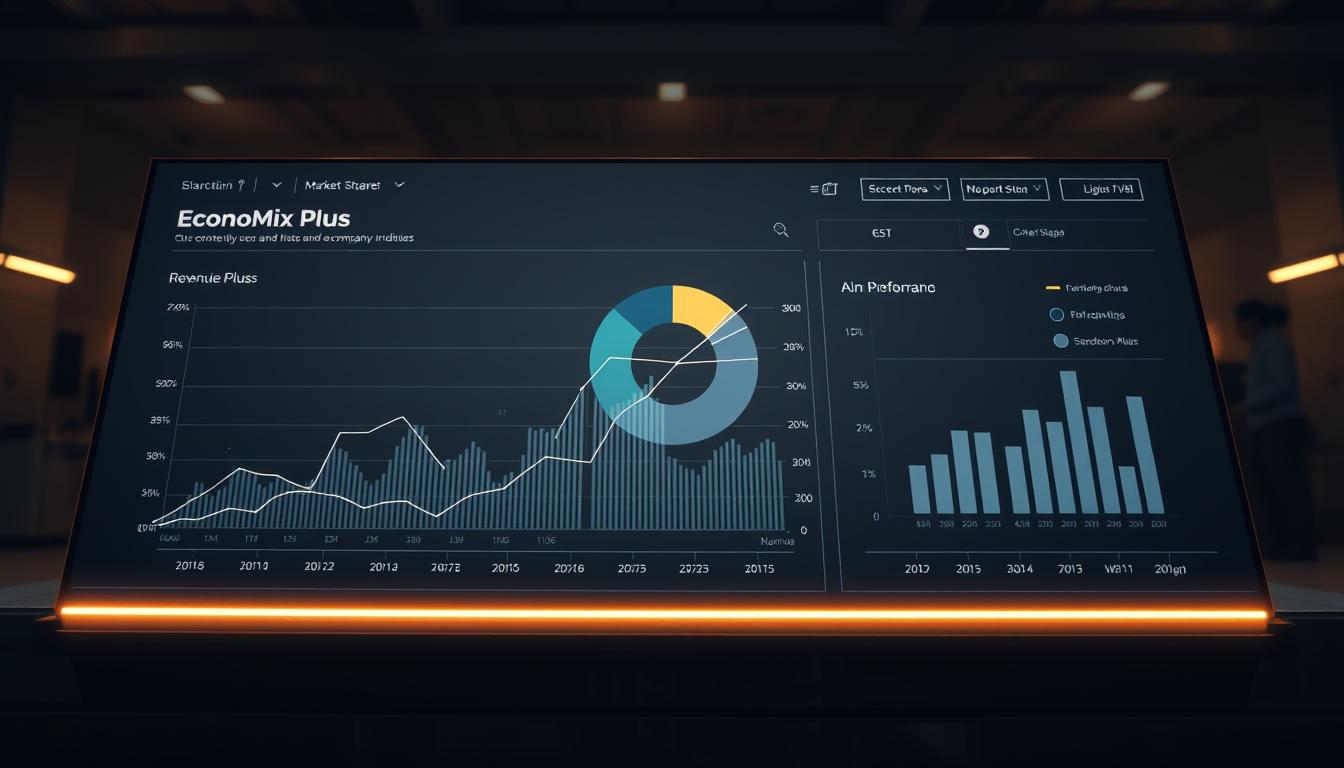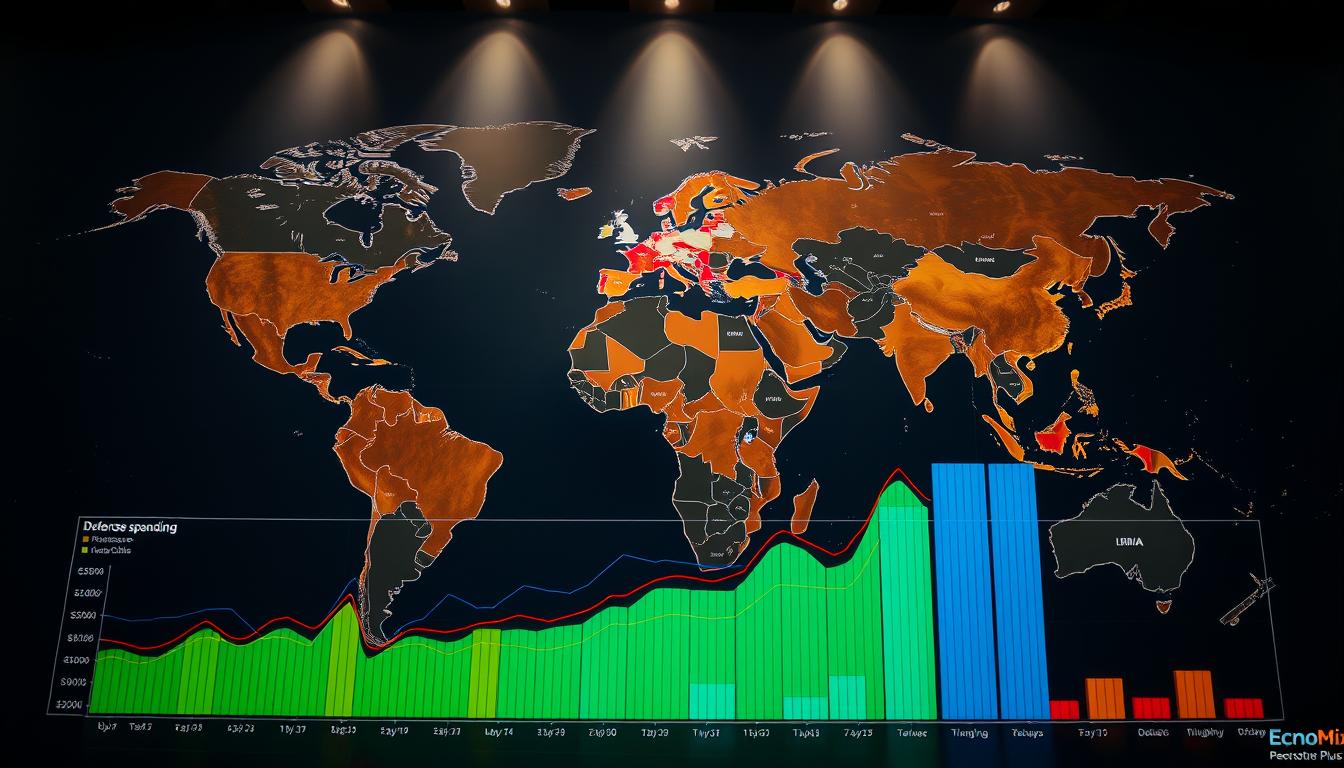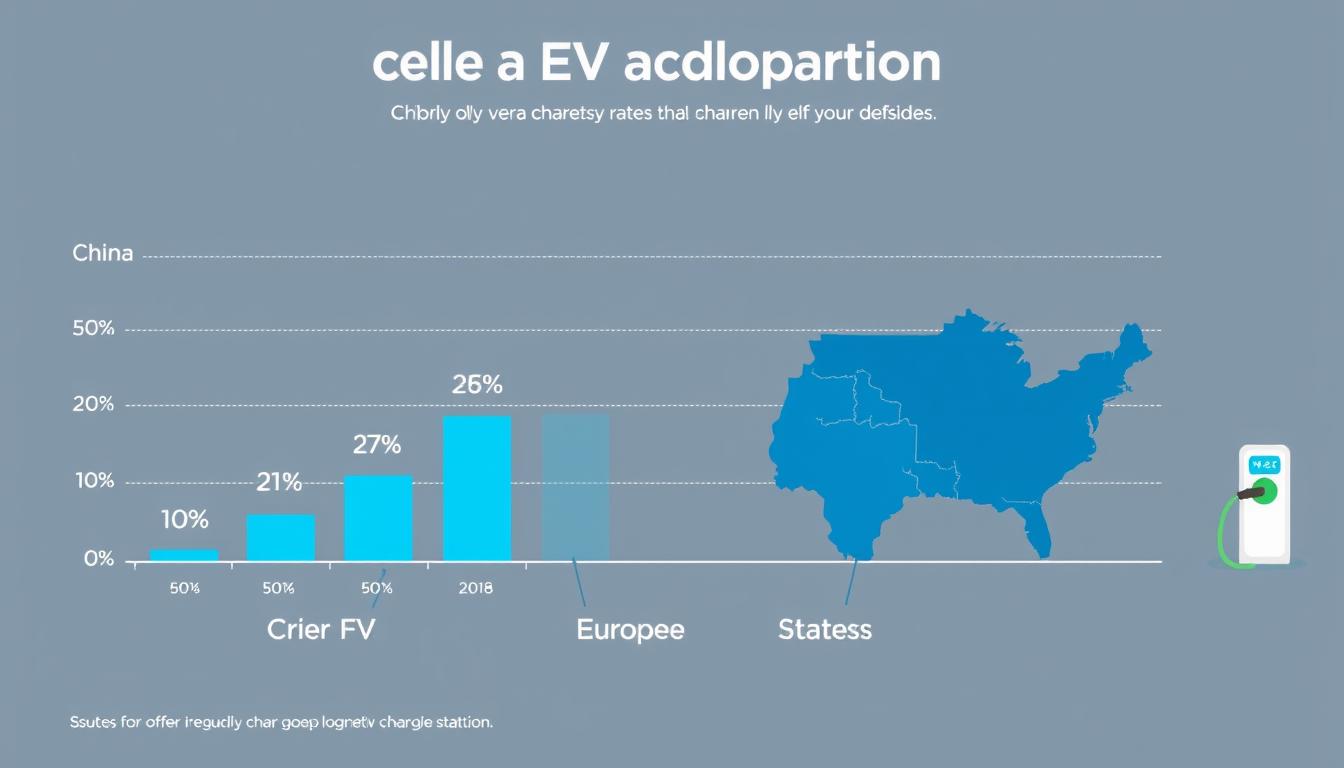Did you know that Lockheed Martin holds a staggering market cap of $114.83 billion in 2024? This makes it the largest contractor for the Pentagon, influencing global defense spending like no other. With a revenue of $67.7 billion, the company plays a pivotal role in shaping the defense budget of nations worldwide.
One in every three U.S. defense dollars flows through its programs, showcasing its dominance in the sector. The F-35 program alone accounts for 33% of its revenue, with over 3,000 jets ordered by NATO air forces. This highlights the company’s critical role in maintaining aerial superiority.
In Q4 2024, Lockheed Martin reported an 8.88% revenue growth, reaching $18.62 billion. Despite a 22.89% decline in net income due to R&D investments, the company continues to innovate. Systems like PAC-3 MSE and HIMARS have proven their battlefield impact, particularly in Ukraine.
Lockheed Martin’s stock price often correlates with geopolitical conflicts, making it a key indicator of global stability and a vital source of information for investors. Its TR3 upgrades ensure it stays ahead of competitors like the Chinese J-20 fleet, presenting challenges for other major players in the defense business, such as General Dynamics. The company’s influence extends beyond economics, shaping strategic policies worldwide.
Key Takeaways
- Lockheed Martin is the largest defense contractor with a $114.83 billion market cap.
- One in three U.S. defense dollars flows through its programs.
- The F-35 program dominates NATO air forces with over 3,000 jets ordered.
- Q4 2024 revenue grew by 8.88% to $18.62 billion.
- Systems like PAC-3 MSE and HIMARS have significant battlefield impact.
- R&D investments led to a 22.89% net income decline in 2024.
- TR3 upgrades maintain aerial dominance against competitors.
Introduction to Lockheed Martin’s Global Influence
Few companies shape global defense spending like Lockheed Martin. With a 23% share of U.S. defense prime contracts, it stands as a cornerstone of national security. Its $421 billion backlog across aeronautics, missiles, space, and rotary segments underscores its dominance in the industry.
The F-35 program exemplifies its reach, with over 3,200 jets ordered globally. In contrast, Russia’s Su-57 has only 76 units, highlighting Lockheed Martin’s unparalleled scale. Its THAAD systems also play a critical role in shaping Middle East defense postures, ensuring regional stability.
In the missiles and fire control segment, the company achieved an 18% year-over-year growth, reflecting the strength of Lockheed Martin aerospace in the industry. This success is driven by advanced technology and a focus on innovation, positioning it among the leading companies in defense.
Lockheed Martin’s leadership in hypersonic development is further cemented by six active DOD contracts, which highlight the country’s investment in modern warfare capabilities and the number of dollars allocated for such advancements.
Production facilities span 16 NATO countries, reinforcing its global presence. European and APAC regions show distinct defense spending drivers, with Europe focusing on collective security and APAC prioritizing territorial defense. Lockheed Martin’s ability to adapt to these needs solidifies its role as a key player in global aerospace and defense.
The Historical Evolution of Lockheed Martin
The journey of Lockheed Martin began over a century ago, rooted in innovation and ambition. Founded in 1912 as Loughead Aircraft Manufacturing, the company started with the F-1 seaplane, marking its entry into the aviation world. Over the decades, it evolved into a dominant force in the defense industry, shaping the future of aerospace and military systems.
From Humble Beginnings to Defense Titan
In its early years, the company focused on designing groundbreaking aircraft. The P-38 Lightning, produced during World War II, became a symbol of its engineering prowess. By 1943, the establishment of Skunk Works introduced a culture of innovation, led by Kelly Johnson, who designed over 40 aircraft. This era laid the foundation for the company’s reputation as a leader in advanced technology.
The Cold War brought new challenges and opportunities. The U-2 incident in 1960 and the deployment of the SR-71 Blackbird in 1966 showcased the company’s ability to deliver cutting-edge systems that many defense companies relied on for their research and development plans.
The Blackbird’s 1976 speed record of 2,193 mph remains unmatched, highlighting its engineering excellence and the importance of defense budget expenditure share across various countries in the chain of military advancements.
Key Milestones in Lockheed Martin’s History
The 1995 merger with Martin Marietta created a $23 billion defense giant, combining aviation and space assets. This strategic move expanded its capabilities and solidified its position in the global market. The F-117 Nighthawk’s impact during the Gulf War, with over 1,300 sorties, demonstrated its battlefield dominance.
Post-9/11, the company experienced significant growth, with a 78% revenue increase from 2001 to 2011. The 2015 acquisition of Sikorsky for $9 billion further diversified its portfolio, reinforcing its role in the defense industry. Today, Lockheed Martin continues to innovate, driving advancements in aircraft, missile defense, and hypersonic technologies.
Financial Performance and Market Position
Revenue and market position are pivotal indicators of a company’s influence in defense. In 2024, the firm reported $67.7 billion in revenue, marking a 7% decline year-over-year. Despite this, its net income stood at $5.34 billion, with a healthy 7.9% margin. A 2.63% dividend yield and 19 consecutive years of increases further underscore its financial stability.

The revenue streams are diverse, with aeronautics leading at 42%, followed by missiles (23%), space (17%), and rotary systems (18%). This balanced portfolio ensures resilience in fluctuating markets and reflects the company’s strategic plans and budget considerations. Compared to competitors, the firm’s 16.99 P/E ratio is lower than Northrop Grumman’s 22.4, indicating a more attractive valuation for investors, despite the challenges in the supply chain and the need for ongoing research and policy adjustments.
Revenue and Growth Trends
Cash flow challenges are evident, with $3.2 billion in capital expenditures and $4 billion in R&D investments. The F-35 TR3 upgrade program, costing $1.8 billion, highlights the firm’s commitment to innovation and strategic plans. Commercial space revenue of $2.1 billion pales in comparison to defense space revenue at $9.4 billion, reflecting the company’s core focus and its expenditure share within the aerospace business.
This analysis showcases the competitive landscape among companies like General Dynamics, emphasizing the importance of revenue research and budget expenditure considerations in the country’s defense sector.Market Capitalization and Financial Health
Long-term debt stands at $12.4 billion, with an average interest rate of 4.3%. This manageable debt profile supports future investments. With a $160 billion backlog, revenue growth is projected at 6-8% for 2025. Participation in the FCAS program signals strategic expansion into the European market, further solidifying its global presence.
Strategic Focus and Key Programs
Strategic programs and cutting-edge technology define the future of aerospace and defense. The firm’s focus on innovation ensures it remains a leader in advanced systems and solutions. From fighter jets to missile defense, its programs shape modern warfare and global security.

F-35 Lightning II: The Core of Strategy
The F-35 Lightning II is a cornerstone of the firm’s aerospace portfolio. With three variants—A, B, and C—it caters to diverse operational needs. Over 17 partner nations rely on this fifth-generation fighter for air superiority.
Recent TR3 upgrades enhance its capabilities, enabling seamless integration into the Joint All-Domain Command and Control (JADC2) framework. By 2026, production targets aim for 156 jets annually, ensuring sustained operational readiness.
Innovations in Missile Defense and Hypersonic Technologies
Missile defense systems like HIMARS have proven their battlefield impact, with over 100 units deployed in Ukraine. These systems provide precision and versatility, reinforcing their strategic value. This information is crucial for countries evaluating their defense plans and the number of systems needed in their military chain of command. Data from the past month indicates a growing interest in such technologies among various nations.
Hypersonic technology is another key focus, with a $2 billion R&D budget through 2027. The AGM-183A program is a direct response to the global hypersonic arms race, competing against systems like China’s DF-ZF.
“Innovation in defense technology is not just about staying ahead; it’s about ensuring global stability.”
The Next Generation Interceptor program, with a $3.7 billion potential, aims to modernize missile defense capabilities. Additionally, the LMXT tanker competition highlights the firm’s commitment to advancing aerial refueling technology.
| Program | Key Details |
|---|---|
| F-35 Lightning II | 156 jets/year by 2026, TR3 upgrades |
| HIMARS | 100+ systems deployed in Ukraine |
| AGM-183A | $2B R&D budget through 2027 |
| Next Generation Interceptor | $3.7B potential, modernizing missile defense |
Classified programs under Skunk Works, valued at $14 billion, continue to push the boundaries of aerospace technology. The development of the Next Generation Air Dominance (NGAD) fighter, targeting initial operational capability by 2030, further underscores the firm’s leadership in defense innovation.
For more insights into global defense spending trends, explore the latest market research.
Geopolitical Impact and Defense Spending Trends
Geopolitical shifts are reshaping defense spending worldwide. Nations are prioritizing their defense budgets to address emerging threats and maintain strategic advantages. This trend is evident across regions, from NATO’s commitment to spending 2% of GDP on defense to the rapid growth of Asia-Pacific expenditure.

Lockheed Martin’s Role in Shaping Global Defense Budgets
With 72% of NATO members now meeting the 2% GDP target, the demand for advanced defense systems is at an all-time high. Lockheed Martin plays a pivotal role in meeting this demand, with programs like the F-35 and PAC-3 MSE deployed in 14 nations. These systems not only enhance national security but also influence global defense strategies, contributing significantly to revenue and defense budget analysis.
In the Asia-Pacific region, defense budgets grew at a 9.4% CAGR from 2020 to 2024. This growth is driven by territorial disputes and the need for modernized military capabilities. Lockheed Martin’s presence in this region ensures it remains a key player in shaping defense policies and meeting operational needs.
Influence on U.S. and International Defense Policies
The U.S. defense expenditure reached $886 billion in FY2024, reflecting its commitment to maintaining global security. Lockheed Martin’s $15 million annual lobbying efforts ensure its programs align with national policy priorities. This influence extends to international agreements like the AUKUS pact, which includes $700 million for SSN-AUKUS submarine technology.
European defense spending varies significantly, with Poland allocating 4% of GDP compared to Germany’s 1.6%. These disparities highlight the diverse approaches to security across the continent. Meanwhile, the Middle East remains a critical market, with the $23 billion UAE F-35 deal underscoring the region’s strategic importance.
“Defense spending is not just about numbers; it’s about ensuring stability in an increasingly uncertain world.”
Potential U.S. defense cuts of 8% could impact global security dynamics. However, initiatives like India’s $130 billion modernization plan and the Space Fence program for orbital conflict preparedness demonstrate the ongoing demand for advanced defense solutions. For more insights into these trends, explore Lockheed Martin’s geopolitical impact.
As global tensions rise, the interplay between defense spending and technological innovation will continue to shape the future of security. Lockheed Martin’s ability to adapt to these changes ensures it remains at the forefront of the industry. For a deeper understanding of how competitors like AVIC are influencing the market, visit AVIC’s global footprint.
Lockheed Martin’s Enduring Legacy in Defense

Over a century of innovation has cemented its role in the defense industry. From biplanes to hypersonic systems, its evolution reflects a commitment to advancing global security. With 114,000 employees across 50+ countries, the company remains a cornerstone of modern aerospace.
Looking ahead, the 2030 landscape will be dominated by AI-enabled systems and multi-domain warfare. However, workforce challenges loom, with 25% of employees retirement-eligible by 2026. Strategic plans include climate tech spin-offs, such as fusion energy investments, ensuring sustainability alongside innovation.
Despite competition, including China’s growing fleet of advanced jets, its 87-year streak of dividend payments highlights financial stability. For more insights into its strategic influence, explore this detailed analysis.
As the defense industry evolves, its ability to integrate space and cyber capabilities will shape the future of warfare. Learn more about its role in modern defense systems.
FAQ
▶
▶
▶
▶
▶
▶














